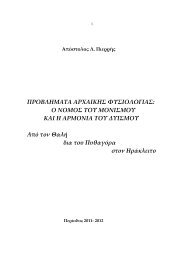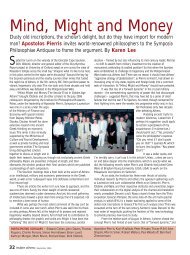APPENDIX C΄ ON DEPILATION: BODY COSMETICS IN CLASSICAL ...
APPENDIX C΄ ON DEPILATION: BODY COSMETICS IN CLASSICAL ...
APPENDIX C΄ ON DEPILATION: BODY COSMETICS IN CLASSICAL ...
You also want an ePaper? Increase the reach of your titles
YUMPU automatically turns print PDFs into web optimized ePapers that Google loves.
<strong>ON</strong> DEPILATI<strong>ON</strong>: <strong>BODY</strong> <strong>COSMETICS</strong> <strong>IN</strong> <strong>CLASSICAL</strong> ANTIQUITY 545<br />
this comparison thus: âΛÓÔ˘˜ ÔsÓ âÁg ˙ËÏá ÙÔf˜ apple·Ï·ÈÔ‡˜, ηd<br />
âΛÓÔ˘˜ ÌÈÌÂÖÛı·È ‚Ô‡ÏÔÌ·È (it is the K˘ÓÈÎfi˜, of course, who speaks<br />
all the time), ÙÔf˜ ‰b ÓÜÓ Ôé ˙ËÏá Ùɘ ı·˘Ì·ÛÙɘ Ù·‡Ù˘ Â鉷ÈÌÔ-<br />
Ó›·˜ w˜ ö¯Ô˘ÛÈ appleÂÚd ÙÚ·apple¤˙·˜ ηd âÛıÉÙ·˜ ηd Ï·›ÓÔÓÙ˜ ηd „ÈÏÔ‡-<br />
ÌÂÓÔÈ appleÄÓ ÙÔÜ ÛÒÌ·ÙÔ˜ ̤ÚÔ˜ ηd Ìˉb ÙáÓ àappleÔÚÚ‹ÙˆÓ ÌˉbÓ Fw<br />
apple¤Ê˘ÎÂÓ ö¯ÂÈÓ âáÓÙ˜.<br />
That this depilation of the whole male body including the pubic<br />
area and the fundament was a far from uncommon practice in Greek<br />
and Roman antiquity usually associated with intense and<br />
unprohibited enjoyment of sexual pleasures, especially of those not<br />
geared to generation, is a certainty, evidence for which will be<br />
presented below. But the point here is that it was not late; it was early,<br />
at least classical. Thus, to give some more examples, Aristophanes,<br />
Ranae, 422 sqq., makes the priest, in the midst of his religiously<br />
significant banter, to say:<br />
ÙeÓ KÏÂÈÛı¤ÓÔ˘˜ ‰’ àÎÔ‡ˆ<br />
âÓ Ù·Ö˜ Ù·Ê·ÖÛÈ appleÚˆÎÙeÓ<br />
Ù›ÏÏÂÈÓ ë·˘ÙÔÜ Î·d Ûapple·Ú¿ÙÙÂÈÓ Ùa˜ ÁÓ¿ıÔ˘˜,<br />
ÎàÎfiappleÙÂÙ’ âÁÎÂ΢Êg˜<br />
ÎôÎÏ·Â ÎàÎÂÎÚ¿ÁÂÈ<br />
‚ÖÓÔÓ, ¬ÛÙȘ âÛÙ›Ó, àÓ·ÊχÛÙÈÔÓ (I put this, for the<br />
mss. àÓ·ÊχÛÙÈÔ˜).<br />
This is an excellent example of sustainedly multi-dimensioned<br />
meaning, of richly interspersed allusions, that one expects from a<br />
supreme comic writer like Aristophanes. Cleisthenes here is made to<br />
mourn for Sebinus’ death in a memorable way. This Cleisthenes was<br />
(in)famous as a ΛӷȉԘ and Á˘Ó·ÈÎÈ˙fiÌÂÓÔ˜ or Á˘Ó·ÈÎ҉˘, v. Sch.<br />
ad Nubes 355: ÔyÙÔ˜ ‰b âappled ÎÈӷȉ›÷· ‰È·‚¿ÏÏÂÙ·È. ÙÔÜÙÔÓ ‰b ó˜<br />
Á˘Ó·ÈÎÈ˙fiÌÂÓÔÓ ÔéÎ \AÚÈÛÙÔÊ¿Ó˘ ‰È·‚¿ÏÏÂÈ ÌfiÓÔÓ indeed in various<br />
places, àÏÏa ηd KÚ·ÙÖÓÔ˜... ÙÔÜÙÔÓ å‰ÔÜÛ·È, ÊËÛ›Ó, ·î NÂʤϷÈ, Âå˜<br />
Á˘Ó·Öη˜ ÌÂÙÂÌfiÚÊˆÛ·Ó ë·˘Ù¿˜. Cf. Suda s.v. KÏÂÈÛı¤ÓÔ˘˜ àÎÚ·Ù¤-<br />
ÛÙÂÚÔ˜, which seems to have become proverbial, and s.v. KÏÂÈÛı¤Ó˘.<br />
He is described as womanlike by Aristophanes in Aves 831 (the<br />
scholiast makes explicit Aristophanes’ meaning), where the point lies<br />
in the contrast to Athena’s manliness; and similarly the scholiast to<br />
Lysistrata 1092 says: ÔyÙÔ˜ È‚˘ÚÙ›Ô˘ apple·Ö˜ âappled ıËχÙËÙÈ ÎˆÌˇˆ‰Ô‡-<br />
ÌÂÓÔ˜. When in Thesmoph. Cleisthenes goes to the meeting of the<br />
women who celebrate the Thesmophoria to disclose that Mnesilochus










